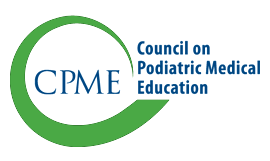What is a podiatric residency?
Following four years of professional education, graduates of colleges or schools of podiatric medicine enter postgraduate residency programs conducted under the sponsorship of a hospital, academic health center, health-care system, or CPME-accredited college of podiatric medicine. Residencies afford these individuals structured learning experiences in patient management along with training in the diagnosis and care of podiatric pathology. The individuals involved in these training programs are referred to as “residents” and are recognized as such by the institutions sponsoring the programs.
What is the Council’s role in residency education?
The Council has been authorized by APMA to accredit institutions that sponsor residency programs that demonstrate and maintain compliance with established standards and requirements. Podiatric residency approval is based on programmatic evaluation and periodic review by the Residency Review Committee (RRC) and the Council.
Why does CPME allow new residencies to open?
It is important to understand that CPME’s role in approving residencies in podiatric medicine and surgery is to ensure that these institutions meet the CPME standards and requirements as outlined in CPME 320, Standards and Requirements for Approval of Podiatric Medicine and Surgery Residencies, and CPME 330, Procedures for Approval of Podiatric Medicine and Surgery Residencies. CPME does not control the market and therefore cannot stop new residency programs from opening if they are able to meet the standards and requirements and provide the minimum volume of cases and clinical experiences required to train residents.
Why does CPME allow residency programs to increase the number of approved positions?
The RRC considers applications for increases in residency positions and approves these applications when an institution can demonstrate that it has the appropriate resources for an increase in residency positions. In addition to ensuring that a program can demonstrate it has sufficient volume of case and procedure activities in all categories to train additional residents, the RRC reviews resident logs to ensure that residents are logging accurately and appropriately.
Why are there two types of residency programs, PMSR and PMSR/RRA?
The only difference between a PMSR program and a PMSR/RRA program is the volume of required foot and ankle surgical cases and Reconstructive Rearfoot/Ankle (RRA) procedures. CPME recognizes that not all podiatric physicians plan to practice surgery; as such, PMSR programs may be better suited for these residents. Students apply to specific residency programs through a national matching service and are matched with and contracted to receive the certificate for the program they complete.
Under special circumstances, program directors may request a PMSR certificate for a resident in a PMSR/RRA who cannot complete the RRA requirement. This request includes a signed attestation of agreement from the resident. An institution that sponsors a PMSR residency may not request a one-time PMSR/RRA certificate even if the resident has met the requirements of a PMSR/RRA. However, a PMSR may apply to reclassify all or a portion of the residency positions to PMSR/RRA. The application to reclassify the residency must be submitted at least six months prior to the resident’s completion of training.
How long are podiatric residency programs?
There has been an evolution of podiatric residency programs over the years. Prior to 2003, there were a variety of program types which could be between one and four years in length. After 2003, programs transitioned to a new, more unified format and programs were required to be a minimum of either two or three years in length depending upon the type of program. An additional year was later added to the two-year programs. Since 2013, all CPME-approved residency programs have been a minimum of three years (36-months) of training.
State licensure requirements vary from state to state. Only practitioners who have successfully completed the CPME approved residency in existence during their years of training may be board-eligible/qualified or board-certified by the CPME recognized certifying boards (ABFAS and ABPM).
Additional questions? See the other CPME FAQs
What is the CPME?
Colleges and Schools of Podiatric Medicine
Residency Programs
Fellowship Programs
Continuing Education Providers
Specialty Boards





